MyHimalayasimpressions from |
|
|||||||
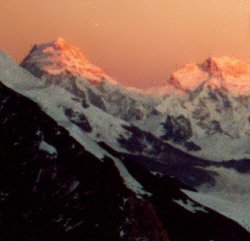
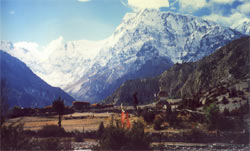
The small village of Chulu has kept its charm since it lies hidden in a
less-frequented sidevalley. Annapurna and Gangapurna rise behind the organ-pipes
and the houses.
![]()
Mountains from Pisang Peak to Annapurna I
(click here for 3D-Panorama-Viewer)
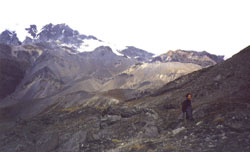
The way from the Marsyangdi valley to the basecamp requires a steep walk through
barren yet colorful gravel slopes.
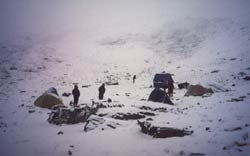
Suddenly bad weather moves in and forces us to spend two nights at -20°C.
Luckily we can move on after a day and set up high camp on the col at 5'500
meters.
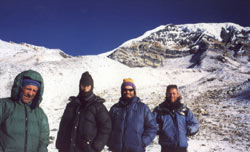
Tom, John, Dana and Jamie in front of Chulu Far East which is climbed on the
left ridge.
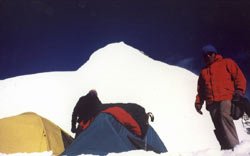
When looking at the summit from high camp at 5'600 meters, the 500 meters to the
peak are much steeper than it looked from further down.
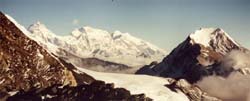
After climbing a nasty scree slope we break camp on the saddle between the
ridges of Chulu East and Chulu Far East. Manaslu (left) rises high above all the
other mountains.
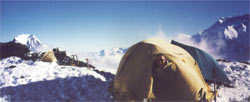
Does Jamie seem to be enjoying this?

View from the Col Camp towards the Annapurna range. Annapurna I (8'091 meters)
is at the very right.

The valley is already in the shade, but the sun is still setting on the Manaslu
massiv. It is a cold night with strong wind, but inside the tent we enjoy the
comfortable atmosphere.
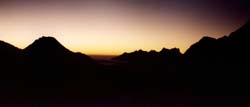
The silhouettes of the mountains stand out against the thin orange line at the
horizon where the sun will rise any moment.
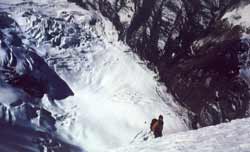
Far down the glacier winds its way through the steep valley.
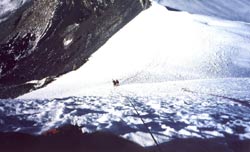
The first steep section which is somewhat less scary when using a rope.
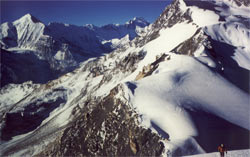
Why do people climb mountains? This picture should answer all questions. View on
the Annapurna range from Gangapurna to Annapurna I (8'091 m) from a flat spot
after our first rope section. Our tents are the two small dots near the ridge
that we climbed up through the black slope on the left.
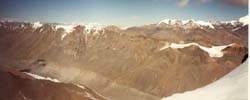
While waiting to climb the summit ridge, we enjoy the views towards Tibet. The
Nar valley just below us is rarely visited by tourists. A destination for the
next trek?
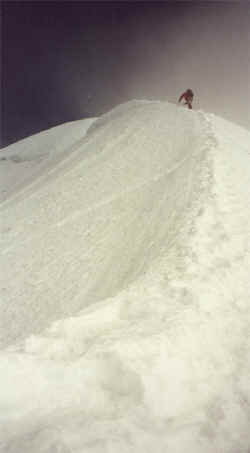
Jamie 'went ahead' to fix rope for the last ridge before the summit. Maybe I am
exaggerating, but certain death lingers on both sides of the narrow ridge. Tom
climbs first, 20 minutes later we all meet on the summit.
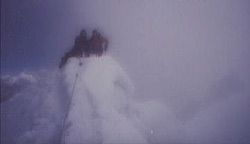
The summit at 6'060 m! And if you don't believe that's me on the left, I will
show you the scars on my hands :)
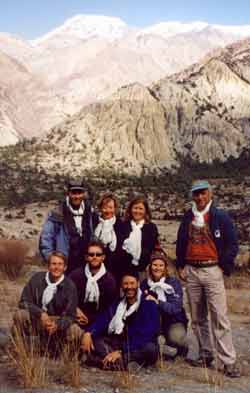
The tourists in front of Chulu Far East:
- Happy about the fantastic trek.
- Looking forward to a hot bathtub and apple pie.
- Destined to come back.
Manaslu: Climbing Chulu Far East
Climbing Chulu Far East
Waterfall camp - Base camp 5'600 m (Day 23)
All fatigue after the first day on the Annapurna Circuit has disappeared: the last two days on the high trail were very rewarding: the views were awesome, the cultural experiences plentiful, now I feel I could continue for many more weeks. Or as Tilman put it more eloquently:
"I felt I could go on like this forever,
that life had little better to offer
than to march day after day in an unknown country
to an unattainable goal."
My indecision whether to attempt the summit or not is also gone: I am excited to try it, and the few things that do worry me - steep slopes, walking on ice, never having climbed a mountain before, the altitude, and mostly my fear of heights - will be dealt with when (and if) it is necessary.
Jamie plans to go to base camp today, then climb another 200 meters to high base camp the next day as an easy day for acclimatization and gaining strength. Then on the third day we will go for the summit of Chulu Far East (6'060 m). At least that is the rough plan, if necessary we can change it quickly because we are not a huge group and our loads are relatively small.
Getting up is made easier by Jamie allowing us to stay in the tent until the sun reaches the valley. Clouds make the mountains more impressive but photographing impossible, soon afterwards the clouds also cover the sky on 'our' side of the valley. Most of the porters will go down to Braga or Hongde. I would have preferred if the women also came on the climb, I usually do not like things that are divided between gender lines (well, except for soccer and a million other things), but that is the way it is and 'the men set off for the mountain'...
A small trail climbs the hill near the two waterfalls, from then on it is a long climb up to the crags high above us. I go deliberately slowly, trying not to sweat or breathe heavily. We will have to walk up to a ridge, somewhere behind in a gentle valley lies the camp. The good trail makes it a straightforward climb with great views, but soon also Pisang Peak is disappearing in clouds. Our destination, the ridge, seems to get farther away the higher we climb. The wind is getting colder. Some tricky gravel slopes need to be crossed but then we reach a calm spot where we wait for the others. Base camp is only a few minutes away and we decide to have pack lunch there. Very light snowfall starts while we are on the way, it gets stronger but visibility is fine and we did not plan to do anything this afternoon anyway. In fact, the bad weather is a good excuse for naps before dinner.
To find a small tent at base camp is a surprise, since none of the porters passed us. It belongs to an English couple that summitted Chulu Far East this morning. They actually planned on staying at high camp and climb more peaks in the coming days, but a wild cat stole all the food they had hidden under some rocks, and then the bad weather moved in. They will go down tomorrow.
Porters are surprisingly fast and before it gets uncomfortable out there we can put up the tents before the snowfalls gets stronger and fog moves in. Lying in the sleeping bag, hearing the snow on the tent and an occasional glimpse out of the tent make this a very comfortable and cozy afternoon. Jamie must has given orders to Tenba to fatten us up for the climb: after chia and noodle soup for teatime we get vegetable soup, spaghetti and beans for dinner, and hot pears for dessert. Needless to say, I have overeaten a little.
When I try to fall asleep I feel the effects of altitude; breathing becomes more irregular and the overfull stomach does not help, on the contrary. But after half an hour later I am sleeping.
Base Camp (Day 24)
The clouds are getting less dense in the morning but it is still snowing when we get up. Actually I do not really get up since Jamie, Ang Dami have slept in the dining tent. What a luxury to enjoy breakfast in the sleeping bag. Now this is what I call a holiday: breakfast in bed!
Jamie's loud calculation on how many days it would take to walk out are a bit worrying: I was not aware that bad weather effects the airstrip in Hongde; if it gets too wet it will be closed for a day or two. Hopefully we will be lucky and get to do the peak and be back in Kathmandu as planned. Usually I would not mind but I really want to meet some friends who were not there a month ago.
I go for a short walk in the morning, but thick fog makes the tent a more luring place and I am soon back in the sleeping bag. It seems to clear up a few times, blue sky and the sun are visible for short moments but then the clouds move in again. After dozing the whole morning I feel a little guilty about my laziness. After lunch I definitely need some exercise and start looking for the cat that stole the food. Chances of finding it are tiny, especially because the footprints that were visible in the morning are less clear now. I set out for some small caves above camp, carefully walking up a slope with slippery boulders and slates. There I traverse over a similar slope, glad to have brought the two ski poles. But the tracks disappear, and the caves higher up would require a longer hike than planned. But at least I get great views of Chulu Far East appearing out of the mist.
I over-eat less than yesterday and have gotten used to the altitude. I fall asleep fast and enjoying a good sleep.
Base Camp - Col Camp (Day 25)
The scenery at night is beautiful; the sky is completely black and the stars seem even brighter than usual. It was the coldest night so far, - 20° C, thanks to Tom's extra sleeping bag not even my feet got cold. Take note to buy new sleeping bag. The views of the mountains in the morning are breathtaking, the play of colors is simply superb. The snow crunches pleasantly under my boots, and the crisp air is refreshing. With good clothes it is very nice and the sun hits soon.
The plan is not to go to high camp but a little further, up the steep scree slope and camp on the col. That is the small notch in the rocks where the snowy part of the peak starts. Two sherpas and two porters will carry loads up and then go back to base camp. We climb up a ridge first, there it becomes relatively flat and easy walking as most snow has melted already in the warm sun. The views of the Annapurna range and Gangapurna peak are getting better the higher we climb. After lunch near the normal high camp we start climbing the scree slope towards the col. It is a hard and difficult climb. The rocks are loose, the slope is steep, and breathing is not getting easier, either. The porters show their skills, and although one complains of headache they are up there many minutes ahead of us.
When I reach the 'pass', the views are sensational: Chulu East is the closest peak to the west, its glacier winds down into a brown barren valley that turns into a desert-like landscape of large ochre mountains with some ice on their ridges and summits. To the right is Chulu Far East, the backside of the ridge that looked so gentle from base camp has turned into something much, much steeper than I actually feel comfortable with. I expected a technically easy but tough walk with maybe a little snow on some spots. But this looks more like serious mountaineering. Of course a real climber would disagree, please bear in mind this is the first time I set foot on a mountain. Maybe I should have read Jamie's description before:
'The Nepal Mountaineering Association (NMA) has classified 18 peaks in Nepal as 'trekking peaks', a misleading name because all involve climbing. Ranging from 5650-6500m (18,537-21,325ft) some are, however, appropriate heights to combine within a trekking program. "Limited bureaucracy" peaks would be a better name.'
Well, climbing is still a day away and for now I enjoy this absolutely stunning campsite. We set up our two tents on the little plateau and make sure they cannot be blown away. We shovel snows for melting and cooking. Not much else needs to be done. The wind gets stronger and since the tent is the coziest place, we almost miss the superb sunset. The gray clouds down in the valleys are barely visible because it is dark there already, the largest peaks like Manaslu, Ngadi Chuli and Himal Chuli seem to flow above everything thing and glow in a pink light.
Then it gets really cold outside, the wind picks up and shakes the tents, it is well below minus 10° C outside. Inside the tent it is very comfortable: Jamie is cooking at the other end, the sound of the stove and the smells create a cozy atmosphere. I expected a more cramped and nervous atmosphere at these camps.
After great vegetarian chilli soup for me and tasty smelling chicken stew and pasta for the others it is bedtime already. Nobody is sick from altitude, but it does effect people's moods. There is some commotion in our neighbors' tent. Tom has a hard time sleeping at altitude and swears occasionally, rumors are that Dana had problems with the pee-bottle. Except for the effects from the bean soup, it is quiet and peaceful in our tent.
Falling asleep is very difficult. Whenever I am dozing off I wake up half a minute later gasping for breath. The first few times it gives me a very eerie feeling, but then I am getting used to it and do not feel like suffocating any more. I thought that breathing problems are normal, but people sometimes take Diamox against it. My breathing becomes more and more regular and two hours later I am asleep and do not wake up again - excluding the normal toilet breaks, of course.
Col Camp - Summit - Base Camp (Day 26)
The two times I get up at night I stare up the slope to the summit, wondering if I will really be standing up there or not. Somehow my optimism has waned, but it is not completely gone - at least not yet.
I do not even want to attempt describing the morning views, because it is impossible. At first there are only black silhouettes of the peaks against a light blue sky, then a fine orange line appears at the horizon where the sun is about to rise, the line becomes brighter and larger, slowly turning the delicate looking black silhouettes into white giants.
Jamie has been up for awhile melting snow and preparing breakfast. After a real Swiss muesli we start getting ready. Jamie gives instructions and helps us put on all the gear, the others have more experience and need less or no advice. I take the first few clumsy steps wearing crampons. The slope becomes steeper gradually which leaves enough time to become more confident. Walking uphill feels comfortable and foolproof, the ice axe is used as additional security. Manaslu and Annapurna I, the two highest peaks in the area, stand out above the dozens of other impressive peaks. After a few minutes our tents are just tiny dots between the glaciers and peaks. As I look down I realize how steep this 'hill' is and can feel a lump in my stomach - which probably does not come from the expired Mars bar I ate yesterday.
Then we reach the first rope-section - Jamie quickly gets up a hundred meters, fixes a rope and we cling in our rope-handle. Usually it is two people on the rope, and then it is just hard work to get up there, pulling yourself and walking up takes a lot of energy. I am usually strong at altitude but like everybody else I am breathless when I reach the end of the rope. There we cling on to another rope and wait until the group is back together. This leaves plenty of time for rest and the heartbeat drops to a normal rate quickly. This 'strategy' also gives us enough time to enjoy the magnificent views. The Annapurna massif is simply spectacular. The glacier from Chulu East is equally stunning.
The camp becomes smaller and smaller, the slope steeper and steeper, yet the strange feeling (probably anxiety mixed with excitement) has waned immensely. I simply enjoy this without worrying anymore. The closer we get to the summit, the worse the weather gets. Fog is coming from the Marsyangdi valley, it is not dense but hides the Annapurna massif in the west. While waiting before the final rope on the summit ridge I have enough time to think and decide that I am actually not too unhappy that the valley deep, deep down below is not visible. It makes it easier for people like me who were afraid of heights until two hours ago...
The valley to the northeast looks very barren, it is probably the restricted Nar valley. Although there are only two villages I see it as a possible destination for the next trip, thanks to an old map from Tilman that shows a pass to Tangbe in Upper Mustang. The people are of Tibetan origin and developed a special dialect so their unpopular neighbors from Manang will not understand them.
I follow the footprints on the narrow ridge. A gap in the ridge (probably a crevasse, though I really do not know much about mountains to be sure) makes me doubt my sanity, but with a jump I get across it easily. Jamie went ahead and fixed ropes at the summit, too. I rest on a small plateau for a minute and get on another rope to climb the last meters to the peak. Gosh, it is steep on both sides. I reach the summit, 6'060 m. It is a very strange feeling to be at the highest point and have nothing around me. Dana comes after me and the whole group spends some minutes together on the summit. Nobody is very talkative and we all hang on to our own thoughts.
I surely do not look graceful as I stand up for a picture, but I did reach the peak. Of course it would have been nicer with good views, but the fog does not bother me at all. The views towards the Tibetan plateau were great, and the views from col camp were so good that they cannot be much better from up here. This is probably a happy moment even for Jamie who has already been on 8'000 m peaks, since he had two unsuccessful attempts on this mountain before.
After some minutes we start descending, and now I realize why - though I was very happy - I did not feel jubilant: Getting down the mountain is also part of the climb, and it is the more difficult part. Walking down that summit ridge seems impossible. The idea of 'abseiling' (walking down backwards, letting the rope slide through your hand to control the speed) seems even scarier, at first. Once I am on the rope I even enjoy it, putting all my weight back and pushing myself off the mountain with my legs is comfortable and easy. I get a little too wanton and miss the narrow ridge once, but somehow manage to get back on the 'trail'. After the plateau, the crevasse needs to be crossed again, Jamie said "you will know what to do when you get there" and really, there are not that many options. I let loose some rope and take a big jump backwards. Then I get to the end of the rope where Dana is waiting. Seeing Jamie undo all the ropes and then walk down the narrow trail with only two ice axes is almost too much to watch.
Some parts of the descent are done with a rope, some parts we walk. I really like the 'abseiling' and think I am doing pretty well, going down is fast and easy. Walking downhill is more difficult than going up; it requires much attention because it is easy to trip over the crampons or hitting yourself. And of course with every step you want to get a good foothold in the frozen snow and that is quite tiring. I can feel my leg muscles after a few dozens steps already. There is probably a better technique, but I have no experience. For a second I am not careful, slip and try to get a grip with my other foot and the ice axe. The first attempt with the ice-axe hits my hand, I slip a meter, then the ice-axe is in the snow and stops me sliding. All this happens in a second and I do not fully realize what happened - or could have happened - until some minutes later.
Tom did not wait for the rest of the group after the first rope, hopefully he will be fine and find the way in the fog. Our way of climbing with all the ropes is safer, but it does take time to fix the rope, wait for everybody to get off the rope, untie the rope and then Jamie climbing down without a rope. Fog and wind makes these stops less pleasant than on the way up, but the windproof clothes keep me warm, and not even my feet get cold in the plastic boots that Jamie lent me. A pair of long underpants, windproof pants, a shirt, fleece and windproof jacket are warm enough. After about four more ropes we are almost 'at home'. Jamie tells us to go on and though I am extremely satisfied to get to camp - the feeling of happiness is overwhelming - I am too worried to enjoy it because Jamie does not show up for many, many minutes. Then he appears out of the mist, rolling up the rope took some time. He has done an incredible job on the mountain (well actually on the whole trip), his experience made everyone feel secure and it all went very smoothly.
We saw Ang Dami and three porters arrived at camp while we were climbing up. The porters are about to leave now without loads. We do not know Jamie's plans and have a hard time convincing the porters to wait some more minutes. They spent some hours up here and are cold, though they could have sat in the tents and cover with all the warm sleeping bags. It is about three o'clock, and we decide to go down to base camp. We set a new record packing up and then head down the scree slope. We walk fast and get down the nasty part quickly. I would probably get lost in the fog on my own, and did not remember the way to base camp to be so long. Eventually we see the tents in the valley below us.
Apart from breakfast, a cereal bar and half a chocolate bar I have not eaten anything the entire day, my water bottle is not empty either. I simply never felt hungry or thirsty. And I realized that I had hit myself with the ice-axe only after taking the gloves off at col camp. Tenba waits for us with hot chai ready. Having such thoughtful people in your crew is what makes trekking so relaxing, since everything is easy and comfortable. A few minutes later I enjoy the hot noodle soup, the kitchen crew seems to be able to read minds. I did not realize that this is just a snack and that regular dinner is still coming. Sadly the excellent dal baht is merely dessert and not the main course (as it deserved to be).
Tom got down safely and left several hours ago. He was heading down to Hongde, probably because he does not like sleeping at altitude. Dana and John are also thinking about continuing, but it is getting dark already. They will start very early tomorrow, go to Braga first and then come to Hongde. Tom got lost in the darkness but with some luck found the way to Nawal and stayed in a lodge there.
I lie awake forever before falling asleep, which is surprising after such a hard day. But the impressions are so strong that whenever I think about it the adrenaline makes sleep impossible. I wake up several times during the night and lie awake, seeing some scenes of the climb over and over again. It was absolutely fantastic, though something I will probably never do again. [When I type it in a few weeks later, I am not so sure about the last sentence anymore.]
Base Camp - Hongde (Day 27)
I am undecided whether to get up early for a detour via Braga, or to enjoy a lazy morning and head to Hongde directly. I wake up early and hear John packing, but it is too cozy in the sleeping bag, looking at the beautiful sunrise, indulging in some leftover snacks and going back to dozing. I skip Braga since I was there some years ago and it probably did not get nicer in the meantime.
After breakfast in the sunshine with great views, Jamie and I take down the tents, pack everything up and clean the campsite as good as possible. I hurry to get down, hoping to spend some time in Chulu and maybe visit the monastic school afterwards. The views are stunning, red and ochre "dunes" (in fact it is barren solid rock, but the play of colors makes it look like sand) are a nice contrast to the endless range of mountains ahead of me. From Pisang Peak to Annapurna I the mountains cover almost the whole. The trail over steep gravel slopes that caused an uncomfortable feeling a few days ago seems like broad freeway now. Running down the hill is easy.
As it hit the trail going down into the lovely valley, I notice many birds near the waterfalls. Swarms of crows and a pair of birds of pray are circling above the same spot. They disappear in a cliff and I put my camera away. Two minutes later I see two shadows on the trail, two different eagles pass 5 meters above my head. A goat fell down the cliff and is a welcome feast.
I quickly get down to the creek and enjoy a nice walk through the forest. The views of the waterfall, the Chulu massif and its peaks are even better when you can see the peak you climbed just a day ago. I miss a fork and have to bushwhack along the creek for some minutes. Apart from a few scratches on my neck I get back to the main trail safely twenty minutes later after some jumps across the river. The scenery is enchanting with its contrasts: the gurgling creek, the pine trees, then the steep rock faces in ochre tones and the snow ridges further up that lead to the peaks. The view down the valley is equally exciting, especially from Chulu village. Three white chortens with water-driven prayerwheels overlook the few houses with haystacks, a whitewashed and redframed chorten stands at the town's entrance, the steep face of Annapurna IV and the peak of Gangapurna rise behind it. It is one of the prettiest villages I have ever seen, the colorful trees and the river make it even nicer.
The village is very small and almost deserted, I hoped to spend more time here. Therefore I start climbing up to visit the monastic school, it sounds better than sitting around in Hongde. While I am walking up the plateau where the school is, I hear and then see a dozen kids running down the hill. Nobody is around by the time I get up there, but then I hear some talking and find 4 young boys sitting on the porch near the tallest building. The oldest kid is wearing a red robe and speaks very good English. Since it is very cold, the monks are allowed to wear casual clothes during the day, the traditional chuba is mandatory only during ceremonies and other religious activities.
33 young monks get their education here in this 'branch', the main monastery is in Kathmandu. Most of them are from the area (Manang, Nawal, Muktinath, Upper Mustang). A few of them are from Tibet - sending children to schools abroad is totally illegal and the Chinese have recently started punishing parents when they found out about it. Not surprisingly, the concept of 'nationality' is not that clear to the kids and some of the kids from Nupri claim to be Tibetans, not Nepali. Probably their parents fled from Tibet after the invasion, maybe there is an area close to the border with the same name.
They hold a puja twice a day, it is one more hour until they meet in the assembly room for praying. Since Hongde should be easy to reach, I decide to stay and watch at least the beginning of the ceremony. More and more kids show up, change into their red robes and gather around me. Tourists do not come here that often. This would be a really good place to learn Tibetan, the children are witty and good teachers. Only three adults stay with them: the head monk is 31 and oversees the religious activities, and older Tibetan who studied in Varanasi University teaches Sanskrit, and another guy works as cook and janitor.
A gong announces the upcoming ceremony, a few of the latecomers run into the chapel just in time. I am allowed to sit inside and watch, though I am really quiet I am a welcome distraction nevertheless. It is a large and chilly room where the monks sit in two rows facing each other. The older kids are further up near the head monk, recite the texts by heart and play the instruments. The younger monks sit near the door, try to follow the others and consult the scripts more often, or just sit and watch the others. The offerings on the altar are changed twice a day during the course of the puja, the three monks who sit separate from the others are obviously proud of their job.
After an hour one monk is taking me to the kitchen where it is much warmer. It is simply impossible to refuse the buttertea, and I even let it be refilled more than the three times which politeness dictates. Butter tea is less threatening after surviving Chulu Far East. The older teacher who spent much time in India is giving lessons in Sanskrit and Tibetan. He fled from Tibet in 1964, spent 12 years in India and has not been in Tibet since then. His father and brother still live in U-Tsang (central Tibet), a few days away from the border. He wants to visit his family but will never ever get a visa, he will try to sneak across the border and hopes to reach his village without meeting a check-post or police. It is incredible that despite all the hardship these people remain so free of bitter feelings. The friendliness and hospitality are mind-blowing: here I am, a complete stranger and they invite me into their house and offer food and drink, and more important: they make me feel welcome.
I have spent almost half a day here and should head down to Hongde before dusk. A steep trail goes directly to the airstrip, luckily the teacher walks with me for some minutes and shows me the best trail. It is a tricky path on washed out freestone, but since it used to get supplies up to the school it is impossible to get lost. I shoo away some strange birds when I walk across the forest, since they cannot fly they run away through the scrubs and make as much noise as large animals. Then I hit the flat valley floor, pass a large village to the left and what looks like a monastery straight ahead. I knock on the door and ask for the key, a really nice and friendly girl named Samden takes a break from dinner and shows me the private chapel. It is not richly decorated, but very well kept and in regular use.
The thought of having to cross the Marsyangdi river only occurs to me when I stand above the wide river and cannot see a bridge. Hoping on good luck I follow it and a few minutes later find a bridge finished 4 August 2000. Needless to say, the old bridge further down does not look very trustworthy. I hear somebody yelling as I get to the airstrip but cannot see anyone and continue straight to the village. There I see Bharat who thought I got lost because everybody else arrived at the lodge some time ago. After joking around with him and the didi (a Tibetan girl he is trying to set me up with once more) and changing news from the last few days we go to our guesthouse.
The last dinner is always something special and I am glad that the kitchen crew is giving us a treat of local cuisine. Black dal, mixed vegetable curry, pickled radish and chicken. It tastes amazing. For dessert we get chocolate cake that is even more delicious than the one in Samdo.
Hongde - Pokhara (Day 28)
The first airplane is for locals only, after landing in Pokhara the same plane will come back to pick us up. I skip regular breakfast, have a few cups of buttertea in the kitchen instead and talk to Manangpas who stop by on their way to have glass of rakshi. A 70-year old speaks proper Lhasa-dialect and I manage to have a short but witty conversation with him.
The first flight takes off just a few meters before the runway ends. Three more tourists want to come on our flight, because they are sick (or pretend to be in the case of a couple from Israel) and could not make it over the pass. But since the runway is short only a limited amount of weight can be taken, one tourist is turned back by the pilot. I feel sorry for her, it is sad to see her walk away as we take off.
Tropical temperatures in Pokhara are the first thing to make you like this place. The great bakeries come second. The lukewarm bathtub did not live up to my expectations at first, but when I see the dark gray water afterwards, the knowledge of being clean again makes up for the missing centigrades. I spend most of the afternoon in a nice cafe at the lakeside, lying in a deck-chair enjoying a good Indian lunch and catching up with my diary.
The sun disappears early behind the hills which subdues the colors of the lake and creates a tranquil atmosphere. It is a stark contrast - just 48 hours ago we were 5'000 meters higher in a desert of snow and ice, now we are in the tropics.
The flight from Hongde was short but in these 25 minutes we saw everything of the last four weeks in 'fast motion'. We fly above deep gorges, see high peaks, even Manaslu and Larkya La, then the narrow valleys, in the end the green rice terraces and the red houses we saw when we started in the low lands. Yet it all seems unreal because flying over the miniature landscape goes so fast and it looks like a world you are not really part of. It is a beautiful scenery, but devoid of the encounters with the people who - to a large extent - make the Himalayas such a special place. That is the biggest reward of trekking.
|
Summary Part 6:
After three weeks of trekking some of us attempt to climb Chulu Far East, a 6'060 m peak near the Annapurna range. After spending a cold night at waterfall camp above Chulu village, we take a small trail that climbs the steep hill - a long ascent up to the crags high above us. While putting up tents in a flat valley at 5'000 meters, it starts snowing. Fog moves in, and the snowing continues the night and the whole next day. During the night, temperaturs drop to -20° C. Luckily the sun is strong and we can continue to Col Camp (5'608 meters) after being stuck for a day. We had time to acclimatize and everybody makes it to the fantastic spot on a saddle between the ridges of Chulu East and Chulu Far East. The views of Manaslu and Annapurna are amazing, sunrise and sunset turn it into a moment none of us will probably ever forget. The atmosphere at camp is very relaxed and cozy. After getting instructions in the morning, we start climbing the hardfrozen snowridge to the peak. Jamie fixes ropes on the steeper parts, while waiting for everybody to climb up we enjoy the superb views. Three hours after starting we all make it to the summit. We descend in thick fog that started coming in an hour ago. I stumble over my crampons, slip and start sliding down the ice flank, while trying to get a grip with the ice-axe I hit my own hand at first but the second attempt saves me from sliding down hundreds of meters. I guess that's what people call 'luck'. Two hours later we are back at Col Camp, pack up quickly and spend the night at base camp. I did not feel jubilant on the summit, only now before falling asleep do I realize that I just successfully reached the summit of a 6'000m mountain - on my first climb ever. Scenes of the climb (and my fall) keep popping up while dozing off. The great views during the flight from Hongde to Pokhara evoke memories of the last four weeks - and I wish I were on my next trek already. |